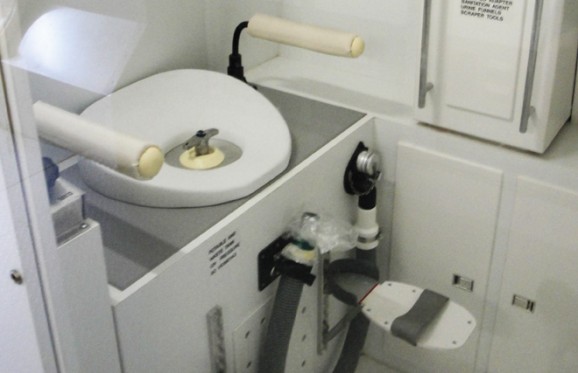Can Astronaut Waste Be Turned Into Fuel?
This article is more than 2 years old
 One of my favorite aspects of Mary Roach’s book Packing for Mars is her hilarious but thorough examination of what happens to astronauts’ bodily functions in space. Given how much these rely on gravity, microgravity is a challenge in many ways, including using the bathroom. I certainly never thought about the advantages of a toilet with a vacuum system before reading the book. But all those messy details may soon amount to more than just a funny story. NASA commissioned researchers at the University of Florida to see how human waste could be useful, and the results indicate that we may be able to make rocket fuel out of astronaut poop.
One of my favorite aspects of Mary Roach’s book Packing for Mars is her hilarious but thorough examination of what happens to astronauts’ bodily functions in space. Given how much these rely on gravity, microgravity is a challenge in many ways, including using the bathroom. I certainly never thought about the advantages of a toilet with a vacuum system before reading the book. But all those messy details may soon amount to more than just a funny story. NASA commissioned researchers at the University of Florida to see how human waste could be useful, and the results indicate that we may be able to make rocket fuel out of astronaut poop.
Just yesterday I was watching a nature documentary that featured small communities living in India just south of the Himalayas. They burn goat and buffalo poop, which establishes the dual purpose of maintaining a degree of cleanliness while also providing cooking and heating energy–though they’re not trying to get rockets off the ground.
The problem with space poop is that there’s nowhere to put it. At the ISS it generally gets dumped into cargo vehicles that have delivered supplies and then burns up in the atmosphere during reentry. But for longer-term space missions, such as colonies on the moon or Mars, that’s not really an option. The lucky University of Florida researchers thus set about the task of figuring out how much methane they might be able to make from space feces, as well as uneaten food and packaging. The main question they sought to answer is whether those waste products could be converted into enough methane to then convert into rocket fuel, thus relieving the rockets of having to carry extra fuel for a return trip. Their findings, which they published in Advances in Space Research, indicate that they can.
Fortunately, NASA gave the research synthetic waste, chemically produced and packaged to simulate the kind produced on a mission. From there, laboratory tests measured how much methane can be made from the waste and how long it takes. Turns out, waste can make a lot of methane, over 75 gallons’ worth per day from a single crew. They were also able to develop a digester process that doesn’t require oxygen, kills pathogens, and breaks down organic matter into a methane and carbon dioxide mix. This same process also generates approximately 200 gallons of water from the same waste. Though the water isn’t safe to drink, it can be useful in plenty of other ways, especially if crop-growing on Mars and/or the moon takes off. What’s more, the water can be divided into hydrogen and oxygen, which allows for a back-up breathing system. The hydrogen coupled with carbon dioxide exhalations can be used to create water and methane, essentially, a closed-loop fuel and resource system.
I guess the astronauts who told Mary Roach that they’d eat as little as possible to avoid having to go to the bathroom are going to have to come up with another strategy.












